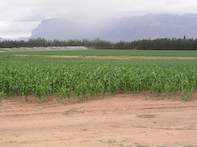Maize is susceptible to many different diseases, with some varieties being more tolerant than others. Maize disease are primarily caused by fungi, bacteria and viruses, which can affect different parts of the plant, from the roots to the cobs.

The occurrence of maize disease is highly dependent on environmental factors, which is why disease risks will not only differ between regions, but also from one part of a farm to another. A maize disease may also be dormant in a land for many years until conditions turn favourable for its development.
Disease Management Tips
What can farmers do to reduce their risks?
Firstly, they need to be aware of the disease risks in their specific region and take preventative actions to lower this risk. This might entail the planting of specific disease tolerant varieties and the planting of a package of varieties to diversify risks, since no variety offers protection against all risks.
Secondly, an expert should be consulted to help with the development of an integrated pest management plan. With integrated pest management, a range of different control measures are used, such as the use of beneficial insects and strategies to improve soil health and plant resilience.
Chemical control is usually used as sparingly as possible and when it is used, products are strictly used according to instruction to prevent the development of disease resistance, environmental pollution or health threats.
Thirdly, efforts should be taken to reduce disease loads at the end of each season, for example through the use of crop rotation, the use of cover crops, chemical control or tillage.
Conservation farming practices, which entails the use of minimum to no-tillage, crop rotation and stubble retention may be a wonderful way of preserving moisture and improving plant health, but it may also enhance problems with certain diseases that may survive on crop residues. Farmers need to consider this and find ways to overcome this problem, either through the use of chemicals or by tilling the land when necessary.
Fourthly, farmers should continuously scout their lands to identify disease problems before these get out of control and cause big financial losses. The use of technology, such as remote sensing and even ordinary aerial photography can help farmers to identify stressed areas in their land, but going out on foot to investigate what is happening in the lands remains important.
Finally, farmers also need to consider the cost of their interventions. Some pests and diseases are more damaging than others, so it will not make financial sense to try and “annihilate” everything.